This story was originally published by NC Policy Watch. Story by Lisa Sorg.
Contaminated soil and groundwater have been found at the former Weaver Fertilizer plant in Winston-Salem, where a devastating fire forced the evacuation of thousands of nearby residents a little over a year ago.
Several soil samples contained high levels of arsenic; groundwater had elevated concentrations of several chemicals, including nitrite, nitrate, and benzene — the latter of which is a known carcinogen.
The initial findings were part of a draft Remedial Investigation Work Plan submitted by independent contractors to the NC Department of Environmental Quality. The firm, Montrose Engineering, used ground-penetrating radar, soil borings and monitoring wells as part of its investigation.
Contractors noted that the extent of the groundwater contamination — both across and beneath the property — is still unknown and needs further sampling and study.
On Jan. 31, 2022, 600 tons of ammonium nitrate caught fire at the Weaver Fertilizer plant at 4440 N. Cherry St. and burned for four days. Emergency management officials asked thousands of nearby residents to voluntarily evacuate, although many chose to shelter in place. Because of the extent of the damage, the cause of the fire has not been determined. The ruins of the main structures have since been razed; a two-story office building — still stands.
Levels of arsenic in the soil were greater than background levels in three spots on the west side of the property, near the former rail spur. The highest concentration was 42.2 part per million. By comparison, that is 62 times greater than the Residential Health-Based Preliminary Soil Remediation Goals.
“It is possible that elevated arsenic in the upper 6 inches of soil is attributable of 80 years of handling fertilizers and micronutrients to and from rail cars,” the report reads. “Commercial phosphate fertilizers contain small amounts of heavy metals such as arsenic and chromium.”
Elevated chromium levels were typical of soil conditions in that part of the state, and contractors believe what they found onsite is naturally occurring.
As for groundwater, monitoring wells showed nitrate and nitrite levels were elevated across the site — unsurprising since fertilizer contains these nitrogen compounds. Three wells indicated nitrate/nitrite levels 15 to 50 times the groundwater standard. The areas with the highest contaminant levels were beneath former stock pile and storage areas.

Arsenic, selenium, lead, cadmium, barium and selenium were also detected above groundwater standards in several monitoring wells. The highest concentrations were detected near the location of a storage tank that was coated in a material containing petroleum.
A spokesperson for the NC Department of Environmental Quality said agency staff is reviewing the report and “will be following up with the consulting regarding specific review comments and next steps.” That review will be publicly available in a few weeks, the spokesperson said.
After the fire, the state Department of Labor and OSHA fined Weaver Fertilizer $5,600 for workplace violations. DEQ cited the company for violations of the Clean Water Act related to a separate location where it was stashing chemicals. Since the building — essentially a large shed — was open-sided, the chemicals were exposed to the elements. That led to contaminated runoff in a nearby creek.
Join the First Amendment Society, a membership that goes directly to funding TCB‘s newsroom.
We believe that reporting can save the world.
The TCB First Amendment Society recognizes the vital role of a free, unfettered press with a bundling of local experiences designed to build community, and unique engagements with our newsroom that will help you understand, and shape, local journalism’s critical role in uplifting the people in our cities.
All revenue goes directly into the newsroom as reporters’ salaries and freelance commissions.


Leave a Reply